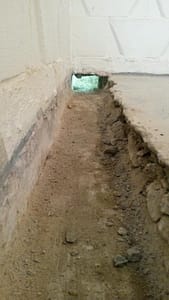Fascination About Best Basement Waterproofing
Fascination About Best Basement Waterproofing
Blog Article
Some Known Facts About Best Basement Waterproofing.
Table of ContentsGetting My Best Basement Waterproofing To WorkSome Known Questions About Best Basement Waterproofing.Best Basement Waterproofing Fundamentals ExplainedSome Known Details About Best Basement Waterproofing Unknown Facts About Best Basement Waterproofing
AdvantaClean's skilled professionals and technicians will certainly find the water source. If wall surface or piece cracks are existing, we will certainly infuse polyurethane and epoxies right into the cracks and seal the compromise, avoiding more moisture from getting in.
If there's condensation on the outside of the aluminum foil, you have high moisture in your basement. Repair it with a portable room dehumidifier or a whole-house humidifier system as opposed to waterproofing products. If the foil has condensation on the within surface (alongside the wall), the soil around your home might be normally damp from a high water table or poor dirt water drainage.
You can waterproof just your indoor wall surfaces, which might solve the issue. Or you can waterproof your exterior walls, which is a far better bet but even more costly. Below's the scoop on the various types: These thick coverings are cement-like. Once they dry, they stick completely to concrete and stonework wall surfaces (Best Basement Waterproofing).
About Best Basement Waterproofing
Swirl the brush at the last of application to provide the wall surface an attractive, finished look. Concrete water resistant layers can't be put on formerly painted surfaces; inspect the tag. A 5-gallon container costs about $60. Additionally understood as densifiers, they are ideal just for wall surfaces that have not been repainted or sealed.
Yet you brush, roll, or spray it on much even more heavily one gallon covers simply 75 square feet, not the 300 square feet typical with typical paint. Waterproof paint is great for DIY application. You can apply it over repainted surfaces, and paint over it once it's cured (one gallon costs $37).
It can set you back $10,000 to $15,000, depending on the work needed. Exterior waterproofing involves digging deep into around your home to the complete depth of the foundation walls, after that mounting a water-proof finish or membrane layer topped by drain panels. The panels provide an easy path for water to flow down to an outside French drainpipe at the end of your foundation.
A cellar without waterproofing is kind of like that. Your basement doesn't want to go via a rainstorm without proper security simply as much as you do not want to.
Best Basement Waterproofing for Beginners
If you have actually done your study, you 'd know there are two kinds of waterproofing: inside and exterior. It can obtain confusing what they both mean, which one's a far better investment, and what will really keep the water out. Do not stress, we created this blog to conveniently define both techniques for you and go over the advantages and disadvantages of each.
Outside waterproofing is a waterproofing method that includes securing your home from the outside. The foundation wall surfaces are after that cleaned, secured, and covered with a water resistant membrane layer or sealer.

How Best Basement Waterproofing can Save You Time, Stress, and Money.
It's a more engaged process that requires excavating up your backyard, which is costly and taxing. Exterior waterproofing entails removing whatever bordering your home, including patios, driveways, sidewalks, landscaping, a/c units, decks, and so forth. If any of the work was done inaccurately and water is still entering your cellar, there isn't much you can do to remedy or repair it.
Interior basement waterproofing entails waterproofing from the within. Any type of water that leakages right into your basement is redirected before it touches your flooring.
It's a reliable technique to water-proof your cellar - Best Basement Waterproofing. The disadvantage of interior cellar waterproofing primarily concerns the setup procedure. This technique needs saved things, furniture, and integrated shelving or cabinets to be relocated from touching the basement walls. And during installation, your basement can't be used. The most significant distinction in between both useful link approaches is this: Outside waterproofing is a preventative remedy and indoor waterproofing is a corrective remedy.
The Only Guide for Best Basement Waterproofing
Finally, exterior and interior cellar waterproofing are both reliable methods of securing your home from water damage. Exterior waterproofing creates an obstacle that avoids water from entering your home, while indoor waterproofing reroutes water that does enter your home. And it is necessary to note that outside waterproofing is an expensive and turbulent setup process when compared to interior waterproofing.
Whichever technique you pick, make sure you select a trustworthy and credible service provider for the task. If you have any type of inquiries regarding cellar waterproofing, please reach out to us.
You can submit our kind here, begin a conversation in the read review bottom right-hand corner, or call us at 1-800-827-0702.
Report this page